Black Creek Club
Tennessee, United States of America
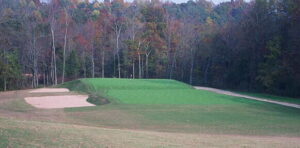
The Biarritz Hole, featuring a 75 yard long green and five foot swale, highlights the fun of playing golf at Black Creek.
After a game, sitting on the porch overlooking the ninth and eighteenth greens, the conversation with Seth Raynor fans invariably turns toward comparing Black Creek with Raynor’s own work. What would Raynor think of this new course, where Brian Silva and the founding members were inspired by Raynor’s design style in their creation of this highly original course? Would Raynor approve of the steep, angled grass bunker faces and the bold green contouring? Would he have done anything significantly different? Would his short holes have been as good? Where does this course fit in the context of Raynor’s work?
As fun as these questions are to bat around, they deflect the conversation away from what matters the most – the eighteen holes that are in the ground. Forget that certain elements were borrowed from the design style of someone else. Heck, how many people even know – or care – who Raynor is?
Following on from his success at Waverly Oaks and Cape Cod National where he utilized bunkers that were perpendicular to the line of play, Silva was encouraged by the founding members at Black Creek to further expound on several features that are often missing from modern architecture, namely: deep bunkering, blind shots, bold green contours, and putting the ball on the ground.
First, the bunkering: it is deep, penal and well placed in that it makes you make decisions. Many of the fairway bunkers have five foot high plus grass faces. Getting the ball back into the fairway with a wedge is often times the prudent play. Gone is seeing the good golfer yell for his ball to get in a bunker as opposed to staying in the rough.
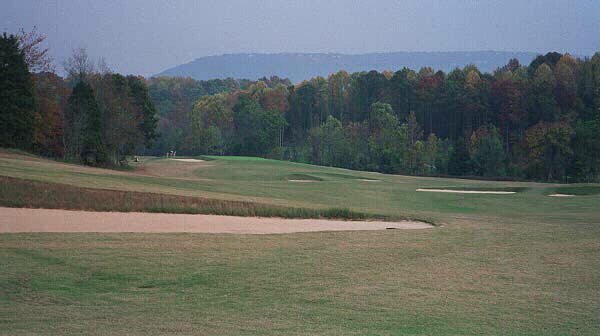
Note the genuine fairway bunkers that dot the 16th fairway.
The numerous genuine fairway bunkers (bunkers that are encircled by fairway) like on the eighth, twelfth, thirteenth, fourteenth, and sixteenth holes also prove perplexing to the better golfer who has grown accustomed to lashing away with his driver with little trepidation. The middle of the fairway is not necessarily safe at Black Creek and the golfer is forced to make clear decisions. Should he go to the right or to the left or stay short of such fairway bunkers? Can he carry them downwind? Whatever the answer today, it may well be different tomorrow given a new hole location and a change in wind. This attribute of playing differently from day to day is a feature that not enough American inland courses enjoy.
As Doug Stein, one of the founding members, notes:
‘One of the characteristics of play at Black Creek that we were able to do even better than Raynor did at Lookout is something I have explained to our members as ‘requiring different corridors of play.’ This is something I saw in Brian’s work at Cape Cod and Waverly Oaks that he improved upon at Black Creek, in my opinion. At the 10th hole, for example, the player with enough length to attempt the green must hit a precise shot or pay the price by going OB or down into the most difficult greenside bunker on the course. Or, he can choose to forfeit his advantage and play wedges against his shorter opponent, who must take the safer route along the left off the tee. And as we all know, those short players tend to have strong wedge games when compared to the ‘Big Putchagaloupies,’ as Brian calls the long hitters. On many modern courses, everyone is required to play down the same hallway- at Black Creek, there are many different paths to the hole. The 16th is a perfect example of what I am talking about- and it also illustrates the fact that it is best to select your hallway from the tee, once you have seen where the pin is that day. Once you have started off on the wrong path, it is difficult to recover without an excellent shot. The spine in the green works in conjunction with the fairway bunkers to reward the well-constructed plan in addition to well-executed shots. Some courses are all about shots, and ignore the plan. It’s always frustrated me to see designs with the 250 slice bunker and the 270 hook bunker off the tee, and no other fairway bunkering to create fabric for the course. One of the most maddening things about that style of bunkering is, a golfer has to hit a fairly decent shot just to get in the damn things! A serious mishit often winds up in better shape than a slight mistake… bunkers in such predictable positions are almost too well thought out. One of the things that impressed me most in working with Brian is the number of times we would be walking down the cleared fairway corridor, and he would say, ‘Hey Big Guy, that looks like a bunker there, doesn’t it?’ And in a bunker would go. The bunker 90 yards off 16 tee was there, for example, and the two bunkers on the right of 13 fairway- the first one of which, of course, is the most talked about fairway bunker on the course- ‘it’s not fair!’ ‘It’s right where you want to hit it!’ Which is, of course, is what makes it perfect. ‘
Another admirable featureof the well positioned bunkering is that, true to Raynor, the bunkers are flat bottomed. Gone are the wimpy, turned up sand faces that help golfers get out of even the shallowest bunkers on other modern courses. Instead, these require good technique and remind one of the days when bunkers were hazards that were meant to be avoided.
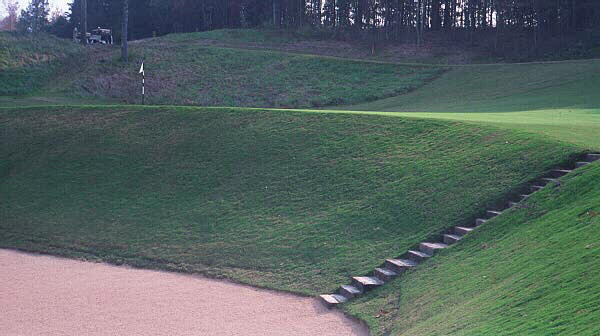
No half-hearted bunkering here! This greenside bunker creates a classic risk/reward situation on the 10th hole: do I try and drive this reachable par four or not?
Flirting with these formidable bunkers is part of the strategy (and fun) of playing at Black Creek. For instance, if the golfer can carry some formidable bunkers for his second shot on the par five sixth and fourteenth holes, he stands a good chance of arriving at the crest of the hill and seeing that his ball has run all the way down onto the blind greens. Of course, if he doesn’t carry it, he’ll be cursing such an old fashioned feature and swear that Alps holes should remain in Scotland! Many architects shy away from blind shots, as do most developers/owners, but not here.
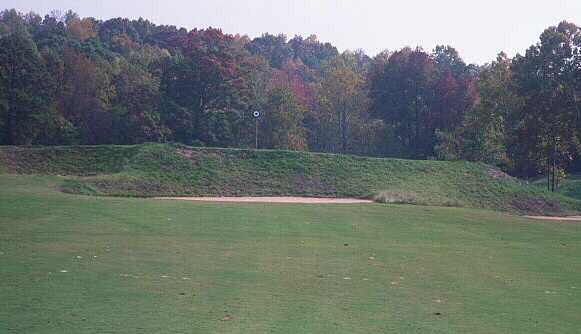
The blind approach to the 6th green. The 14,000 sq.ft. Punchbowl green is fifty yards beyond this ridge and the downhill slope of fairway feeds the ball onto it.
As for the green contouring, creating a 75 yard long Biarritz green with a five foot swale near the middle is a little bit like recreating the Road Hole at St. Andrews. What kind of mad man would design such a green in this day and age? Same would apply to the third green with its soap dish impression, and the mammoth Punchbowl green, and the greens that run away from the golfer, etc.It is a delight to find such varied greens re-introduced into modern course design.
Finally, there are plenty of holes at Black Creek like the Biarrtiz hole where Silva encourages/asks/forces the golfer to put the ball on the ground. Many such examples are highlighted below and include the sweeping hook approach to the fourth, the tee balls on the Redan and the mirror image Redan holes, andthe drivable tenth and fifteenth holes. In such instances, the golfer is watching the ball roll for between 20-60 yards. The slow unfolding of drama is offered on few modern courses where too often the ball sticks where it lands, be it in a lake or five yards short of a green or on the green itself. The design of Black Creek is well removed from such boring golf.
Holes to Note
First hole, 425 yards; A wake-up call that this course is different. The six foot high grass face in the fairway bunker located 160 yards from the green may take the green out of reach. Some golfers will be shocked: how dare they build fairway bunkers that actually penalize my shots?! The green itself is a Double Plateau that will have non-Raynor golfers scratching their heads in bewilderment.

The high grass face of the 1st hole fairway bunker makes it problematic to reach the distant green in regulation.
4th hole, 545 yards; Similar to some of the strategic dilemmas posed by the Road Hole, can the golfer hug Black Creek on the right with his drive and then sling a hook in that a) is long enough to avoid the eight foot deep bunker that fronts the green while b) taking the Indy turn bank behind the green and releasing across the green? What an attractive shot to pull off – for the last twenty yards, the ball will be travelling perpendicular to its original line! Good architecture is about encouraging golfers to attempt shots that they normally don’t play – and this hole is a fine example of doing just that.
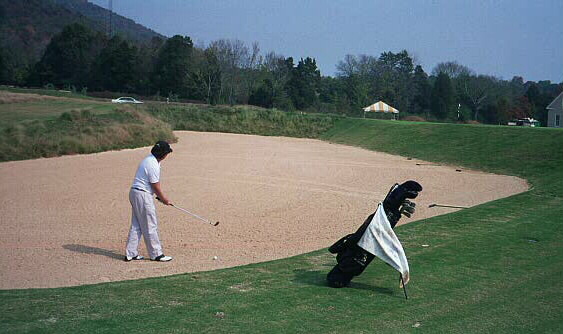
This approach to the 4th hooked too soon, leaving the golfer a difficult (!) up and down for birdie.
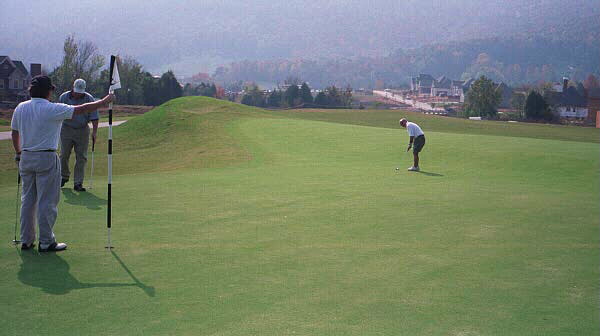
The kick-back or Indy turn pictured to the left of Brian Silva can be used to run the ball the width of the 4th green.
Sixth hole, 560 yards; This original hole is a compliment to the three parties responsible for making Black Creek a success. First, the founders for not shying away from a reachable par five to a blind 14,000 square foot (!) green. Secondly, to the architect for creating something from nothing and building an immense Punchbowl green that still drains properly. Thirdly, to Greenkeeper Scott Wicker and his crew for maintaining the ridge sixty yards shy of the green in a wild manner and maintaining hard and fast playing surfaces that allow the ball to run 40 yards onto the Punchbowl green. Often times, the correct club for reaching this green in two can be 3 clubs less than you might hit on a more conventional hole.
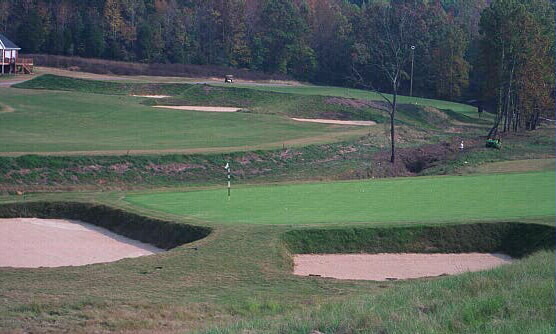
This view across the 7th green toward the 6th hole highlights the ridge that bisects the 6th fairway and the directional marker behind the Punchbowl green.
Seventh hole, 215 yards; A well constructed mirror image Redan that possesses what many lack: enough left to right slope to feed the ball down to the far right hole locations. A well struck long iron will land the ball in the neck and to watch it as it takes the slope and slowly rolls across the green for what seems like days is a sheer delight.

Note the sufficient tilt of the Reverse Redan green.
Eleventh hole, 180 yards; As exemplified here, golf at Black Creek is about playing the angles well. This one shotter is in the midst of a series of two shot holes (the ninth, tenth, twelfth, and thirteenth) where there is either deep bunkers or a stream that cut across the left face of the green at something like a 45 degree angle. Properly judging the approach shots in this stretch is at the heart of the challenge of Black Creek.
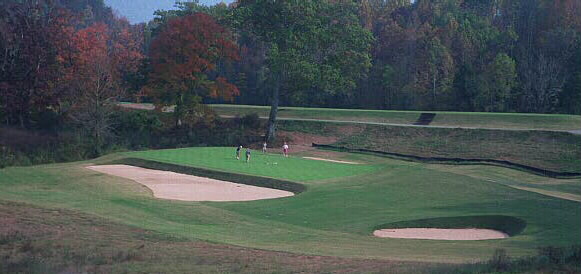
The ten foot deep bunker behind the Redan green is barely visible. A draw that hits front right will release across the green.
Twelfth hole, 460 yards; Many people’s favorite hole on the course because it has it all: natural beauty, fairway bunkers that create strategy/uncertainty, a perfectly situated green site with Dry Branch cutting across the fairway and hugging the left side of the elevated green, and heaps of short game interest. A first rate golf hole that highlights how well Silva routed the course around the numerous creeks and gullies. Silva had to reroute the creek once (50 yards short of the 7th green) but otherwise, the creeks and gullies at Black Creek are where nature put them.
Fifteenth hole, 355 yards; An original version of a Cape hole, a spine in the fairway will kick any ball that hits left middle further left, giving it a good chance of bounding onto the green. However, the golfer knows for sure that he wants to avoid the wetland areas down the left, and many a steer/block drive can result. From anywhere long right in the fairway, the angle of the pitch is nothing short of horrible. Indeed, the golfer may struggle to just hit the green and get away with a two putt par. Thus, some players elect to play an iron off the tee. By staying back in the fairway, the right hand greenside bunker won’t cripple the angle as much. Coupled with the original version of the Alps/Punchbowl sixth hole and the drivable tenth hole, the Raynor fan appreciates that Silva’s original adaptations are some of the best holes on the course.
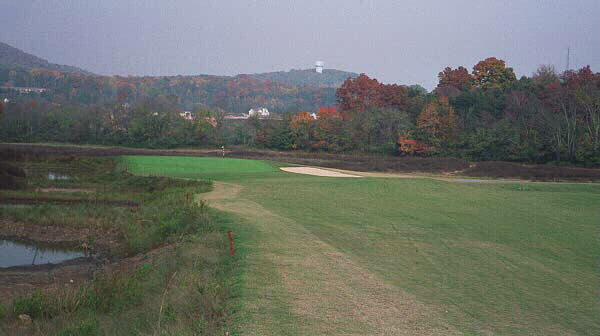
The clever version of a drivable Cape Hole.
Seventeenth hole, 210 yards; As fun to play as any hole built in the past fifty years, it shows the commitment of the founders: such a green is neither inexpensive to build nor easy to maintain but they never once considered having anything other than a full length Biarritz green. To see a ball hit the front shelf and then disappear into the swale … only to eventually reappear and take the slope up to the back shelf, is as good as golf can get. The full length Biarritz green canmake club selection varyas much as five clubs (!) and the Club consciously presents the one shot holes each day in a manner that requires as much diversity in club selection as possible.

The Biarritz green as seen from the right.
The founders of Black Creek are members of Raynor’s nearby Lookout Mountain. Their dream of paying tribute to Raynor’s design style was made possible by making Black Creek part of a housing development. Without the housing, the course would never have been built.
Momentarily, until the trees and shrubs fill in on the edge of the property, the housing competes with the golf holes for the attention of the golfer’s eye. Interestingly enough, though, Raynor’s engineered look helps hold the attention of the golfer. Regardless of the housing, based on any hole by hole analysis, this design sticks out as a gem, even if you have never heard of a fellow called Raynor.

Looking back down the 13th fairway toward the 12th green, the appeal of back nine’s rolling terrain is evident.
The End

